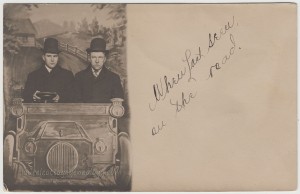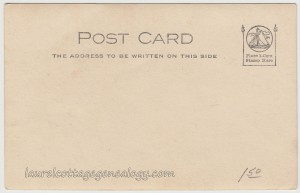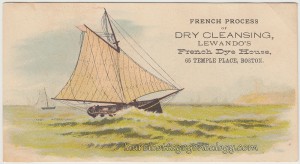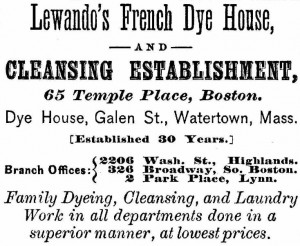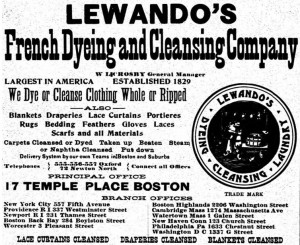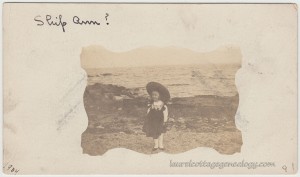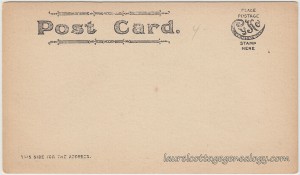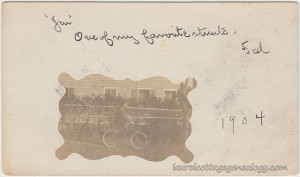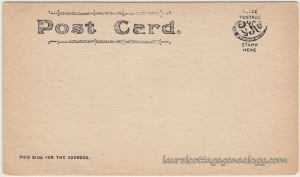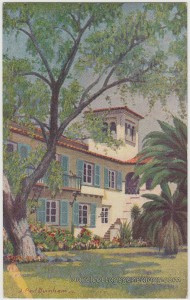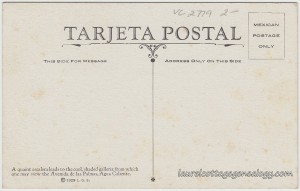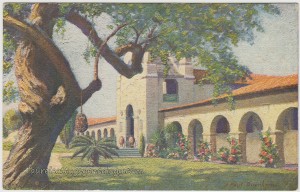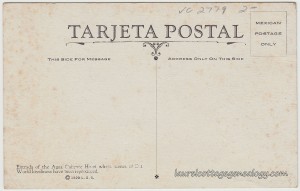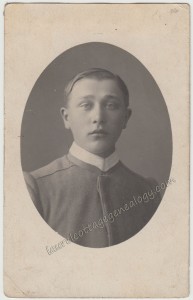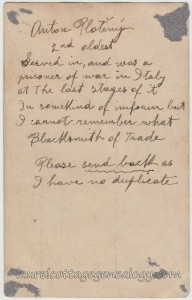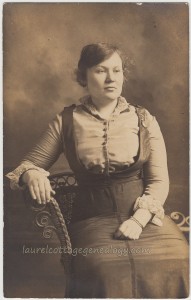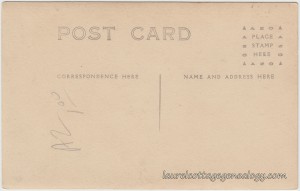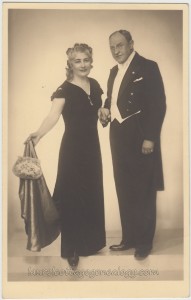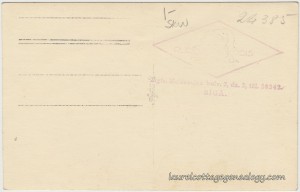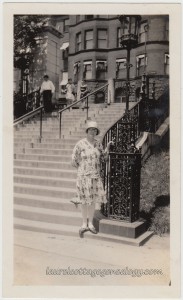
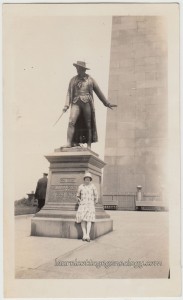
Here is our hostess for this time travel virtual tour of the Boston area, Provincetown, Massachusetts and Central Park, New York City. The photos have present-day writing (mostly done in pencil) on the back, indicating places and dates. There is no identifying information for the woman. (I love her cloche hat and round horn-rimmed eyeglasses.)
The back of the photo on the left says “Boston Commons, 1928.” For anyone not familiar, Boston Common is the central park in downtown Boston. It is almost 50 acres in size and was built in 1634, which makes it the oldest public park in the United States. It is sometimes erroneously referred to with the “s” on Common, as is the case on the back of the photo.
The photo on the right was taken at Bunker Hill, Charlestown, Mass., 1928. Our unknown sightseer is posing at the statue of Colonel William Prescott, who is best known for leading his rebel forces at the Battle of Bunker Hill, and instructing his troops, “Do not fire until you see the whites of their eyes.”
Sources: Boston Common. n.d. http://en.wikipedia.org/wiki/Boston_Common. (accessed March 29, 2015).
William Prescott. n.d. http://en.wikipedia.org/wiki/William_Prescott. (accessed March 29, 2015).
MASSACHUSETTS STATE HOUSE, BOSTON, 1928
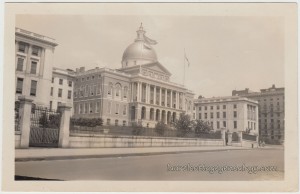
Massachusetts State House, Boston 1928. The State House (or Statehouse) was built between 1795 – 1797 on Beacon Hill, and overlooks Boston Common. This historical landmark, housing the government offices for the Commonwealth of Massachusetts, was designed by architect Charles Bulfinch (having since been enlarged) and is considered a masterpiece of Federal style architecture.
Source: Massachusetts State House. n.d. http://en.wikipedia.org/wiki/Massachusetts_State_House. (accessed March 29, 2015).
STEAMER BETTY ALDEN
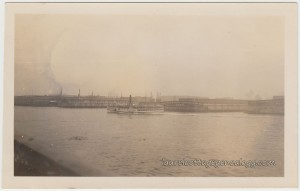
Steamer Betty Alden, Boston Harbor 1928 or 1929. This passenger steamship, owned by Nantasket Beach Steamship Co., was built in 1908 and was lost to fire in 1929. If you enlarge the photo you can read the sign on one of the pier buildings showing “Merchants & Miners Transportation Co., Pier 2.”
According to a 1908 New York Times newspaper article, this steamship was named by Miss Betty Alden, who taught school in Middleborough, Massachusetts. Miss Alden was a direct descendant of Pilgrams, Priscilla Williams and John Alden.
Sources: Atlantic Ironworks, East Boston, MA. Shipbuilding History. Web accessed March 29, 2015. [http://www.shipbuildinghistory.com/history/shipyards/719thcentury/atlantic.htm]
“Betty Alden Names A Ship.” New York Times, 26 Jan. 1908. Web accessed March 29, 2015. (Newspapers.com)
BOSTON HARBOR
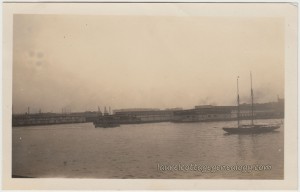
Boston Harbor, 1928 or 1929. This photo shows a couple of boats, one appears to be a small steamer, and the other a two-masted sailboat, with sails furled. At the shoreline we see another view of the Merchants & Miners building, and the large sign on the adjacent building showing, “New York, New Haven & Hartford Railroad, Pier 1.”
ON BOARD A STEAMER ON CAPE COD BAY
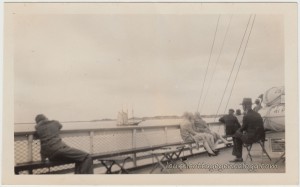
On board a steamer, Cape Cod Bay, off of Provincetown, Massachusetts, 1928. This photo shows nine passengers on the steamer’s deck and taking in the view of the water and a sailing vessel with three masts. The gentleman on our left appears to be taking a photo. Note the three ladies further down on the bench, dressed almost identically.
ANOTHER CAPE CODE BAY VIEW
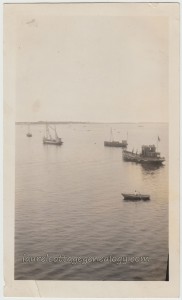
A view of Cape Cod Bay, off of Provincetown, Mass. 1928 or 1929, showing various vessels, including a rowboat with a gentleman in the act of rowing – leaned back, arms extended, both oars in the water.
A PIER AT PROVINCETOWN
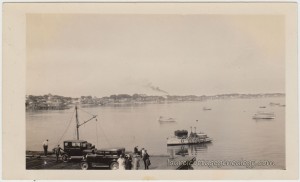
Cape Cod Bay and Provincetown, Mass. 1928 or 1929. At the pier showing a couple of cars and various people standing or seated. The signage on the boat closest to us shows “Mobileoils Gasoline.”
USS V-4 – TRIALS OFF THE COAST AT PROVINCETOWN
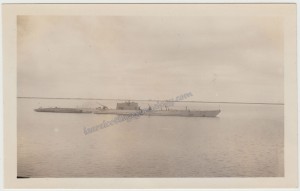
A shot of submarine USS V-4, (later USS Argonaut) taken during trials in January – February 1929, off the coast at Provincetown, Mass. During these trials she submerged to 318 feet (97 meters) which was a record depth at that time. She was also the largest non-nuclear sub ever commissioned by the U.S. Navy: laid down as V-4 on May 1, 1925 at the Portsmouth Navy Yard; launched November 10, 1927; commissioned April 2, 1928; renamed Argonaut on February 19, 1931. She saw pre-war duty at Pearl Harbor and served in WWII. On January 2, 1943, she sank the Japanese gunboat Ebon Maru, in the Bismark Sea. She met her demise during combat eight days later on January 10th, with a loss of all 105 men on board. (The Wiki article indicates 102, other sources indicate 105.) Her bell, however, remains: It is housed in the belfry of the Pearl Harbor Submarine Base Chapel on Oahu, and poignantly tolls for her own crew and those of the other 51 U.S. Navy subs lost during the war. See a wonderful article, “Bells Left Behind.”
One unexpected fact about this boat (submarines are called boats) is that in 1931 she was heavily featured in the film “Seas Beneath” directed by John Ford. V-4 appeared as a fictional WWI German sub, “U-172.”
Sources: USS Argonaut (SM-1). n.d. http://en.wikipedia.org/wiki/USS_Argonaut_%28SM-1%29. (accessed March 29, 2015).
Jones, Col. Charles A. “Bells Left Behind.” Web accessed March 29, 2015. [http://www.navy.mil/navydata/cno/n87/usw/issue_10/bells.html]
CENTRAL PARK, NEW YORK CITY, 1930
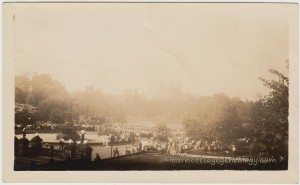
Central Park, New York City showing some type of event, 1930. On the left you can see Bethesda Fountain, also known as the “Angel of the Waters” statue, designed by Emma Stebbins in 1868, and dedicated in 1873. The angel holds a lily in one hand, and with the other outstretched, she offers a blessing on the “water.” Of course in this photo, the fountain is dry. The sculpture was erected to commemorate the 1842 opening of the Croton Aqueduct, which supplied fresh water to the city of New York. Beneath the angel are four cherubs, representing health, purity, temperance and peace.
Source: Bethesda Statue. Central Park. Web accessed March 29, 2015. [http://www.centralpark.com/guide/attractions/bethesda-terrace/bethesda-fountain.html]
Set of 10 photos, 1928 – 1930. Sizes: 4 and 1/2 x 2 and 3/4″ or 2 and 3/4 x 4 and 1/2″
Price: $50.00

